Creating Flet extension for existing Flutter package
Introduction
While Flet controls leverage many built-in Flutter widgets, enabling the creation of complex applications, not all Flutter widgets or third-party packages can be directly supported by the Flet team or included within the core Flet framework.
To address this, the Flet framework provides an extensibility mechanism. This allows you to incorporate widgets and APIs from your own custom Flutter packages or third-party libraries directly into your Flet application.
In this guide, you will learn how to create Flet extension from template and then customize it to integrate 3rd-party Flutter package into your Flet app or share it with community.
Prerequisites
To integrate custom Flutter package into Flet you need to have basic understanding of how to create Flutter apps and packages in Dart language and have Flutter development environment configured. See Flutter Getting Started for more information about Flutter and Dart.
Create Flet extension from template
Flet now makes it easy to create and build projects with your custom controls based on Flutter widgets or Flutter 3rd-party packages. In the example below, we will be creating a custom Flet extension based on the flutter_spinkit package.
-
Create new virtual enviroment and install Flet there.
-
Create new Flet extension project from template:
flet create --template extension --project-name flet-spinkit
A project with new FletSpinkit control will be created. The control is just a Flutter Text widget with text property, which we will customize later.
- Build your app.
Flet project created from extension template has examples/flet_spinkit_example folder with the example app.
When in the folder where your pyproject.toml for the app is (examples/flet_spinkit_example), run flet build command, for example, for macos:
flet build macos -v
Open the app and see the new custom Flet Control:
open build/macos/flet-spinkit-example.app

- Change your app.
Once the project was built for desktop once, you can make changes to your python files and run it without re-building.
First, if you are not using uv, install dependencies from pyproject.toml:
pip install .
or
poetry install
Now you can make changes to your example app main.py:
import flet as ft
from flet_spinkit import FletSpinkit
def main(page: ft.Page):
page.vertical_alignment = ft.MainAxisAlignment.CENTER
page.horizontal_alignment = ft.CrossAxisAlignment.CENTER
page.add(
ft.Container(
height=150,
width=300,
alignment=ft.alignment.center,
bgcolor=ft.Colors.PINK_200,
content=FletSpinkit(
tooltip="My new PINK FletSpinkit Control tooltip",
value="My new PINK FletSpinkit Flet Control",
),
),
)
ft.app(main)
and run:
flet run
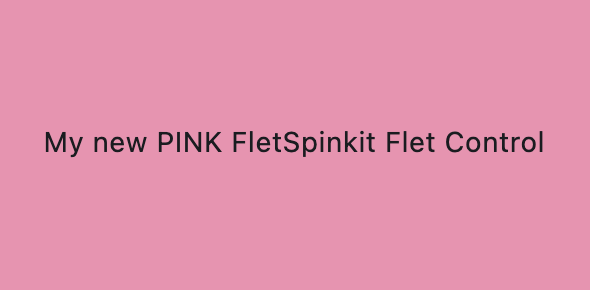
- Re-build your app.
When you make any changes to your flutter package, you need to re-build:
flet build macos -v
If you need to debug, run this command:
build/macos/flet-spinkit-example.app/Contents/MacOS/flet-spinkit-example --debug
Integrate 3rd-party Flutter package
Let's integrate flutter_spinkit package into our Flet app.
- Add dependency.
Go to src/flutter/flet_spinkit folder and run this command to add dependency to flutter_spinkit to pubspec.yaml:
flutter pub add flutter_spinkit
Read more information about using Flutter packages here.
- Modify
dartfile.
In the src/flutter/flet_spinkit/lib/src/flet_spinkit.dart file, add import statement and replace Text widget with SpinKitRotatingCircle widget:
import 'package:flet/flet.dart';
import 'package:flutter/material.dart';
import 'package:flutter_spinkit/flutter_spinkit.dart';
class FletSpinkitControl extends StatelessWidget {
final Control? parent;
final Control control;
const FletSpinkitControl({
super.key,
required this.parent,
required this.control,
});
@override
Widget build(BuildContext context) {
Widget myControl = SpinKitRotatingCircle(
color: Colors.red,
size: 100.0,
);
return constrainedControl(context, myControl, parent, control);
}
}
- Rebuild your example app.
Go to examples/flet_spinkit_example, clear cache and rebuild your app:
flet build macos -v
- Run your app:
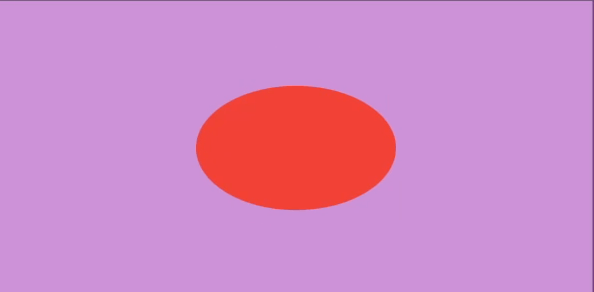
Flet extension structure
After creating new Flet project from extension template, you will see the following folder structure:
├── LICENSE
├── mkdocs.yml
├── README.md
├── docs
│ └── index.md
│ └── FletSpinkit.md
├── examples
│ └── flet_spinkit_example
│ ├── README.md
│ ├── pyproject.toml
│ └── src
│ └── main.py
├── pyproject.toml
└── src
├── flet_spinkit
│ ├── __init__.py
│ └── flet_spinkit.py
└── flutter
└── flet_spinkit
├── CHANGELOG.md
├── LICENSE
├── README.md
├── lib
│ ├── flet_spinkit.dart
│ └── src
│ ├── create_control.dart
│ └── flet_spinkit.dart
└── pubspec.yaml
Flet extension consists of:
- package, located in
srcfolder - example app, located in
examples/flet-spinkit_examplefolder - docs, located in
docsfolder
Package
Package is the component that will be used in your app. It contists of two parts: Python and Flutter.
Python
flet_spinkit.py
Here you create Flet Python control - a Python class that you use in your Flet app.
The minumal requirements for this class is that it has to be inherited from Flet Control and it has to
have _get_control_name method that will return the control name. This name should be the same as args.control.type
we check in the create_control.dart file.
Flutter
pubspec.yaml
A yaml file containing metadata that specifies the package's dependencies.
There is already a dependency to flet created from template. You need to add there a dependency to Flutter package for which you are creating your extension.
flet_spinkit.dart
Two methods are exported:
createControl- called to create a widget that corresponds to a control on Python side.ensureInitialized- called once on Flet program start.
src/create_control.dart
Creates Flutter widget based on control names returned by the Control's _get_control_name() function. This mechanism iterates through all third-party packages and returns the first matching widget.
src/flet_spinkit.dart
Here you create Flutter "wrapper" widget that will build Flutter widget or API that you want to use in your Flet app.
Wrapper widget passes the state of Python control down to a Flutter widget, that will be displayed on a page, and provides an API to route events from Flutter widget back to Python control.
Example app
src/main.py
Python program that uses Flet Python control.
pyproject.toml
Here you specify dependency to your package, which can be:
- Path dependency
Absolute path to your Flet extension folder, for example:
dependencies = [
"flet-spinkit @ file:///Users/user-name/projects/flet-spinkit",
"flet>=0.26.0",
]
- Git dependency
Link to git repository, for example:
dependencies = [
"flet-ads @ git+https://github.com/flet-dev/flet-ads.git",
"flet>=0.26.0",
]
- PyPi dependency
Name of the package published on pypi.org, for example:
dependencies = [
"flet-ads",
"flet>=0.26.0",
]
Docs
If you are planning to share your extension with community, you can easily generate documenation from your source code using mkdocs.
Flet extension comes with docs folder containing initial files for your documentation and mkdocs.yml.
Run the following command to see how your docs look locally:
mkdocs serve
Open http://127.0.0.1:8000 in your browser:
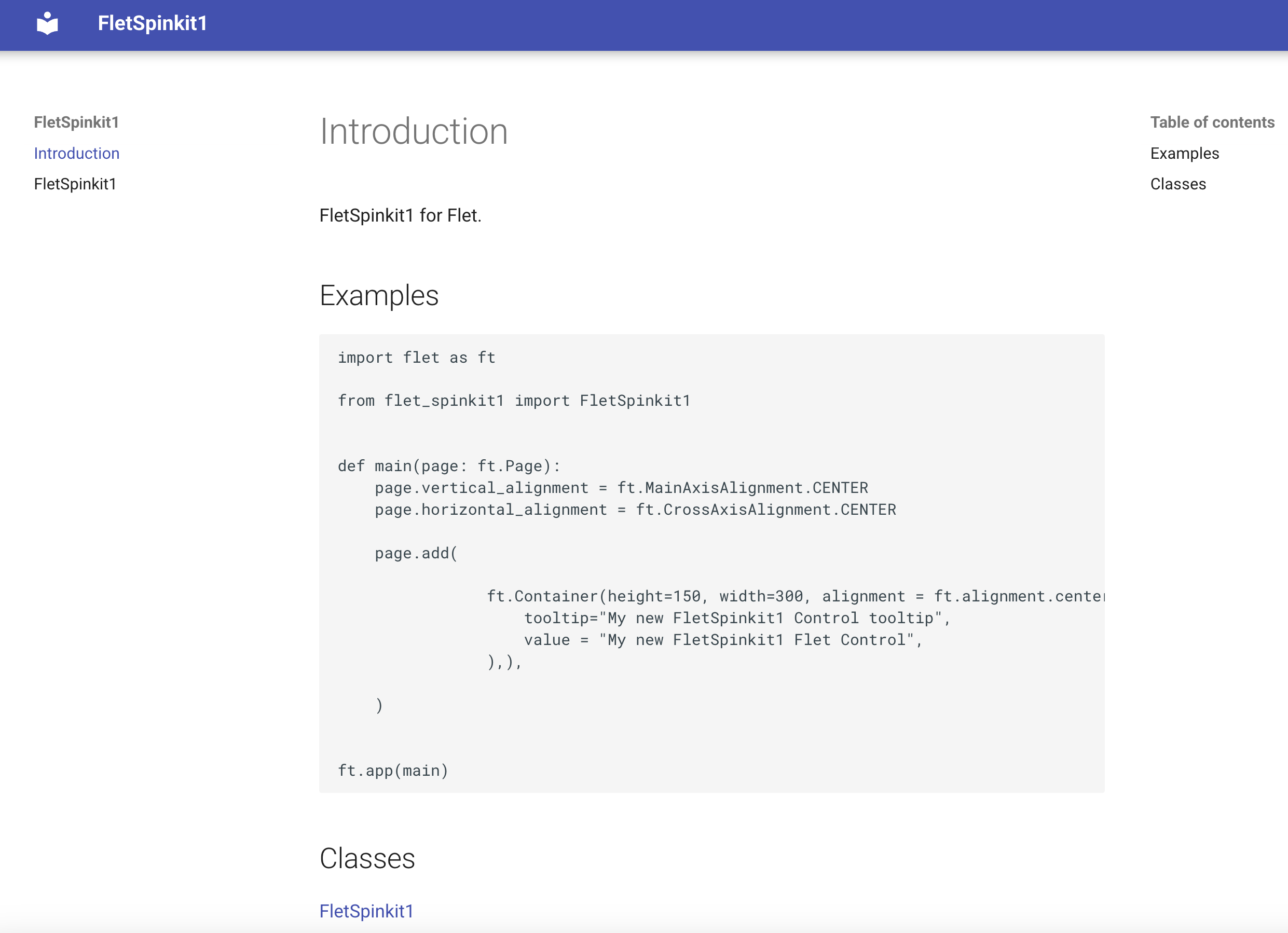
Once your documentation is ready, if your package is hosted on GitHub, your can run the following command to host your documentation on GitHub pages:
mkdocs gh-deploy
You may find this guide helpful to get started with mkdocs.
Customize properties
In the example above, Spinkit control creates a hardcoded Flutter widget. Now let's customize its properties.
Common properties
Generally, there are two types of controls in Flet:
-
Visual controls that are added to the app/page surface, such as FletSpinkit.
-
Non-visual controls that can be:
-
popup controls (dialogs, pickers, panels etc.).
-
services that are added to
overlay, such as Video or Audio.
-
Flet Control class has properties common for all controls such as visible, opacity and tooltip, to name a few.
Flet ConstrainedControl class is inherited from Control and has many additional properties such as top and left for its position within Stack and a bunch of animation properties.
When creating non-visual control, your Python control should be inherited from 'Control. Then, to be able to use Control properties in your app, you need to add them to the constructor of your Python Control. In its dart counterpart (src/flet_spinkit.dart) use baseControl() to wrap your Flutter widget.
When creating visual control, your Python control should be inherited from ConstrainedControl. In its dart counterpart (src/flet_spinkit.dart) use constrainedControl() to wrap your Flutter widget.
Then, to be able to use Control and ConstrainedControl properties in your app, you need to add them to the constructor of your Python Control.
See reference for the common Control properties here.
If you have created your extension project from Flet extension template, your Python Control is already inherited from ConstrainedControl and you can use its properties in your example app:
import flet as ft
from flet_spinkit import FletSpinkit
def main(page: ft.Page):
page.vertical_alignment = ft.MainAxisAlignment.CENTER
page.horizontal_alignment = ft.CrossAxisAlignment.CENTER
page.add(
ft.Stack(
[
ft.Container(height=200, width=200, bgcolor=ft.Colors.BLUE_100),
FletSpinkit(opacity=0.5, tooltip="Spinkit tooltip", top=0, left=0),
]
)
)
ft.app(main)
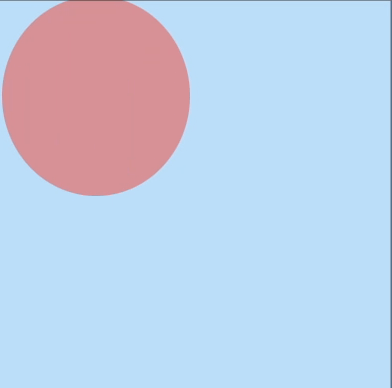
Control-specific properties
Now that you have taken full advantage of the properties Flet Control and ConstrainedControl offer, let's define the properties that are specific to the new Control you are building.
In the FletSpinkit example, let's define its color and size.
In Python class, define new color and size properties:
from enum import Enum
from typing import Any, Optional
from flet.core.constrained_control import ConstrainedControl
from flet.core.control import OptionalNumber
from flet.core.types import ColorEnums, ColorValue
class FletSpinkit(ConstrainedControl):
"""
FletSpinkit Control.
"""
def __init__(
self,
#
# Control
#
opacity: OptionalNumber = None,
tooltip: Optional[str] = None,
visible: Optional[bool] = None,
data: Any = None,
#
# ConstrainedControl
#
left: OptionalNumber = None,
top: OptionalNumber = None,
right: OptionalNumber = None,
bottom: OptionalNumber = None,
#
# FletSpinkit specific
#
color: Optional[ColorValue] = None,
size: OptionalNumber = None,
):
ConstrainedControl.__init__(
self,
tooltip=tooltip,
opacity=opacity,
visible=visible,
data=data,
left=left,
top=top,
right=right,
bottom=bottom,
)
self.color = color
self.size = size
def _get_control_name(self):
return "flet_spinkit"
# color
@property
def color(self) -> Optional[ColorValue]:
return self.__color
@color.setter
def color(self, value: Optional[ColorValue]):
self.__color = value
self._set_enum_attr("color", value, ColorEnums)
# size
@property
def size(self):
return self._get_attr("size")
@size.setter
def size(self, value):
self._set_attr("size", value)
In src/flet_spinkit.dart file, use helper methods attrColor and attrDouble to access color and size values:
import 'package:flet/flet.dart';
import 'package:flutter/material.dart';
import 'package:flutter_spinkit/flutter_spinkit.dart';
class FletSpinkitControl extends StatelessWidget {
final Control? parent;
final Control control;
const FletSpinkitControl({
super.key,
required this.parent,
required this.control,
});
@override
Widget build(BuildContext context) {
var color = control.attrColor("color", context);
var size = control.attrDouble("size");
Widget myControl = SpinKitRotatingCircle(
color: color,
size: size ?? 100,
);
return constrainedControl(context, myControl, parent, control);
}
}
Use color and size properties in your app:
import flet as ft
from flet_spinkit import FletSpinkit
def main(page: ft.Page):
page.vertical_alignment = ft.MainAxisAlignment.CENTER
page.horizontal_alignment = ft.CrossAxisAlignment.CENTER
page.add(
ft.Stack(
[
ft.Container(height=200, width=200, bgcolor=ft.Colors.BLUE_100),
FletSpinkit(
opacity=0.5,
tooltip="Spinkit tooltip",
top=0,
left=0,
color=ft.Colors.YELLOW,
size=150,
),
]
)
)
ft.app(main)
Re-build and run:
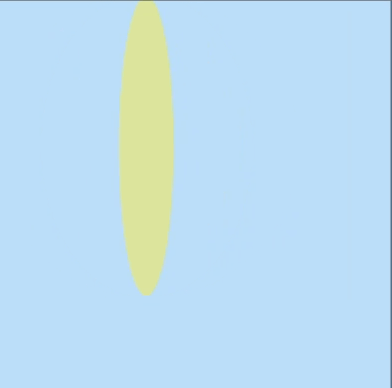
You can find source code for this example here.
Examples for different types of properties and events
Enum properties
For example, clip_behaviour for AppBar.
In Python:
# clip_behavior
@property
def clip_behavior(self) -> Optional[ClipBehavior]:
return self._get_attr("clipBehavior")
@clip_behavior.setter
def clip_behavior(self, value: Optional[ClipBehavior]):
self._set_attr(
"clipBehavior",
value.value if isinstance(value, ClipBehavior) else value,
)
In Dart:
var clipBehavior = Clip.values.firstWhere(
(e) =>
e.name.toLowerCase() ==
widget.control.attrString("clipBehavior", "")!.toLowerCase(),
orElse: () => Clip.none);
Json properties
For example, shape property for Card.
In Python:
def before_update(self):
super().before_update()
self._set_attr_json("shape", self.__shape)
# shape
@property
def shape(self) -> Optional[OutlinedBorder]:
return self.__shape
@shape.setter
def shape(self, value: Optional[OutlinedBorder]):
self.__shape = value
In Dart:
var shape = parseOutlinedBorder(control, "shape")
Children
For example, content for AlertDialog:
In Python:
def _get_children(self):
children = []
if self.__content:
self.__content._set_attr_internal("n", "content")
children.append(self.__content)
return children
In Dart:
var contentCtrls =
widget.children.where((c) => c.name == "content" && c.isVisible);
Events
For example, on_click event for ElevatedButton.
In Python:
# on_click
@property
def on_click(self):
return self._get_event_handler("click")
@on_click.setter
def on_click(self, handler):
self._add_event_handler("click", handler)
In Dart:
Function()? onPressed = !disabled
? () {
debugPrint("Button ${widget.control.id} clicked!");
if (url != "") {
openWebBrowser(url,
webWindowName: widget.control.attrString("urlTarget"));
}
widget.backend.triggerControlEvent(widget.control.id, "click");
}
: null;
Examples
Flet has controls that are implemented as built-in extensions and could serve as a starting point for your own controls.